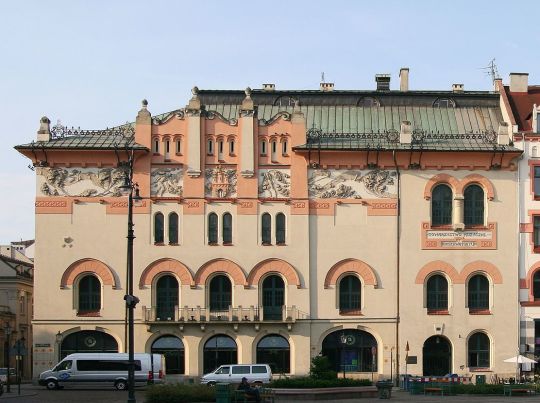|
Art and Architecture in Poland Art and architecture are a testimony to the splendor of the past. It is common for paintings, sculpture and architecture to bear hidden meanings which mirror the economic and political circumstances of the nation. Poland never played a leading artistic role in Europe, yet many renowned foreign and native artists lived and worked here. Because for centuries Poland was the country where East met West, many visiting artists from Germany, the Orthodox East, Italy or Holland have left their mark here. The variety of influences left Poland with a large number of fascinating and valuable art treasures and in a variety of styles. Ruthenian artists from the East painted the Byzantine frescoes at the same time when the German sculptor from Nuremberg, Veit Stoss, made the high altar at St. Mary's Church in Krakow, the high point of the Northern Gothic. |
 The religious orders which established their communities in Poland in the 12th century brought with them well established Romanesque art. Other medieval artists came to work for the Piast Dynasty rulers. Artists from various Germanic states contributed greatly to the development of early medieval art, but the Italian and French also had significant influence. Cistercian monks were the first to introduce Gothic forms in architecture, and the best Gothic buildings were created under the reign of king Kazimierz the Great, who founded some eighty castles, many churches and numerous defensive city walls. In the same time in the North, the Teutonic Knights erected imposing brick defensive castles and fortified towns. As part of the Hanseatic League, the towns in the territories of the Teutonic Knights enjoyed prosperity and attracted artists from many other parts of Europe.  Italian Renaissance was introduced to Poland by artists from Tuscany, such as Bartolomeo Berecci, who was the architect of the Sigismund Chapel at the Wawel Cathedral in Krakow. Fine art was also purchased abroad. The collection of tapestries from Brussels, now at the Wawel Castle, was an important 16th century art purchase. Italian and Nederlandish architects contributed to some of the best Mannerist architecture in Poland. Artists mainly from Rome, but also from the North continued to influence Polish art into the 17th century. It is at this time that magnificent castles, such as the Royal Castle in Warsaw or the Lancut Castle were built.  While well-known foreign architects worked on splendid Baroque palaces and churches, a specifically Polish country manor house was introduced at this time by the local masons who remain unknown. Built of timbre and stone, it was a single story house featuring a front portico and bays at either end of the facade and became popular with less affluent gentry. King Stanislaus Augustus Poniatowski patronized the Neoclassical style in Polish art. Hoping to establish a national museum and academy of fine arts, he brought the next generation of Italian and French artists who worked at his court. |
At the beginning of the 20th century, the innovative Art Nouveau became popular in Poland, which at the time was still under Partitions. The best examples of the style, marked by fresh decorative motifs can be found in Krakow and Lodz.  The postwar period started with a heroic effort to to reconstruct destroyed towns and cities, and considering the level of destruction one must be impressed. Meanwhile in architecture, the communist regime imposed Socialist Realism. The most known example in this style is the Palace of Culture and Science in Warsaw.  Since the 1960s Poland has followed European trends in art, although on a much lesser scale. Considering the amount of war destruction and the fact that the country did not receive any external assistance from the Marshall Plan, which helped other European nations to rebuild, any artful architecture that was created in those years should be considered remarkable.  |





